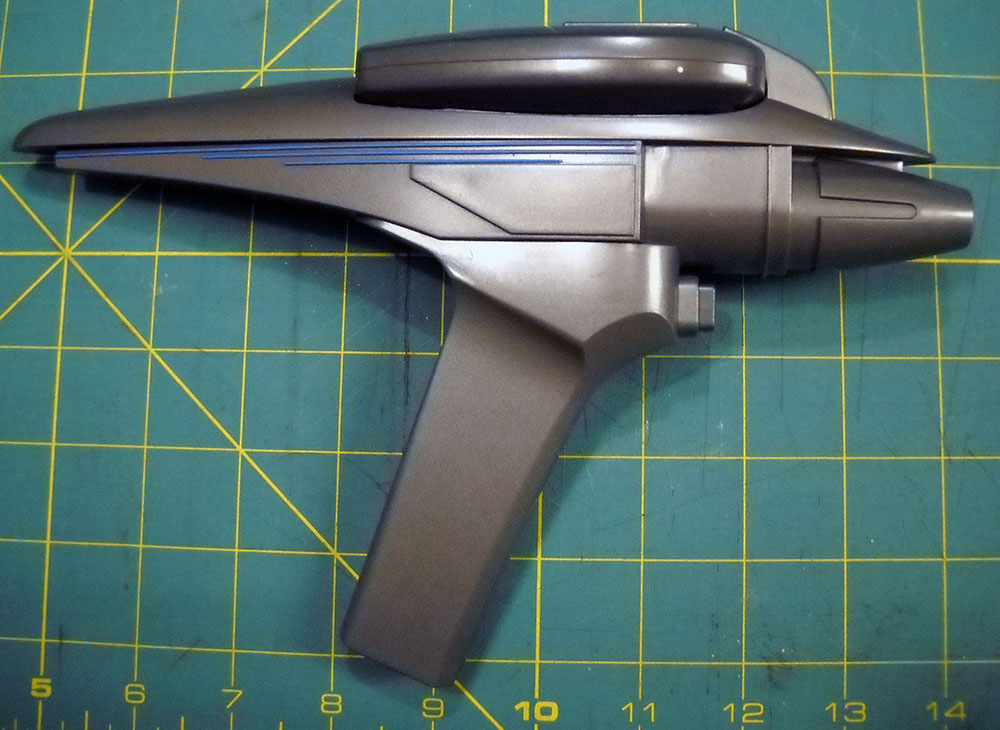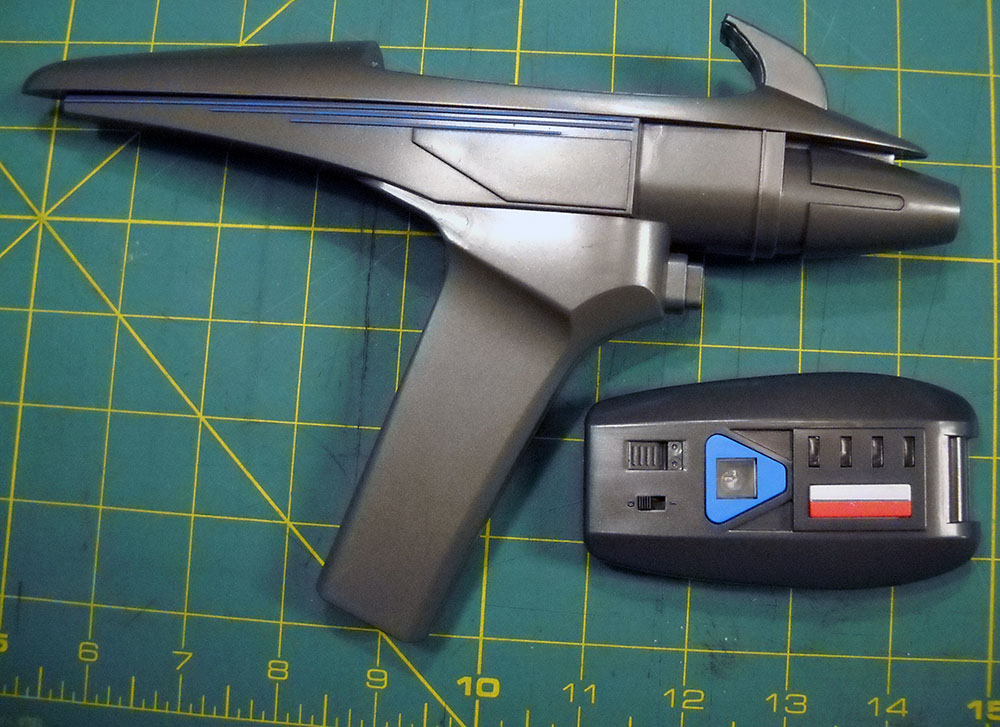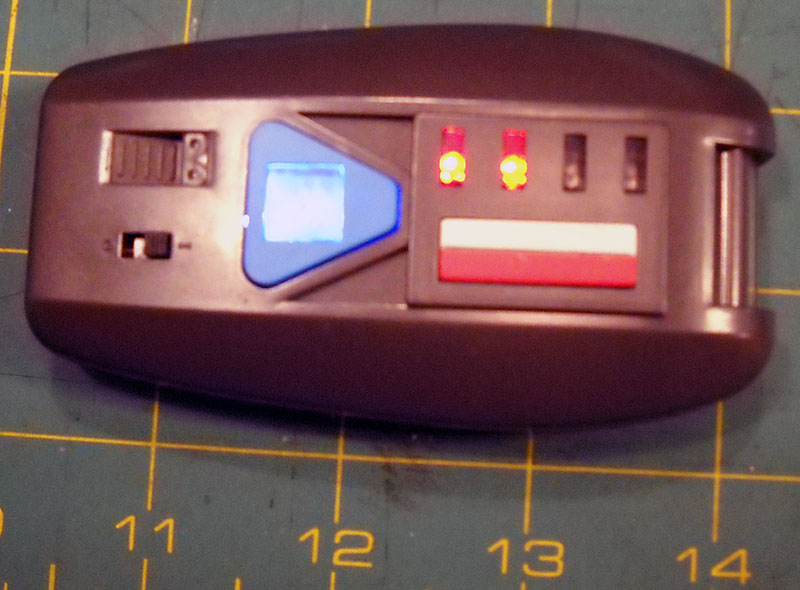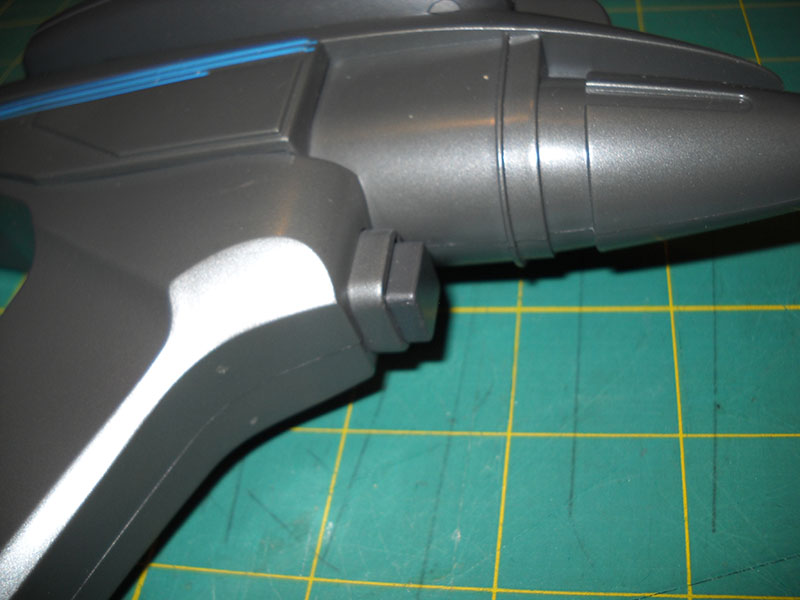

Originally posted May 28, 2017
Lasers and plasma pulse weapons worked fine as sidearms for the old United Earth Space Force. Truth to tell, they really didn't need sidearms. It wasn't as though they were getting out of their rocketships to do a lot of man-to-whatever fightin'. When the Space Force became Starfleet, though—when the Warp 5 engine became a reality and Earth's spacers started to really stretch their legs and explore—it became immediately apparent that something more powerful, and more versatile, was going to be required, personal-weapon-wise.
The first attempt at such a weapon, devised by Starfleet Armory Division in the 2140s, was the phased plasma beam pistol, which applied a phased energy field to a stream of plasma similar to that employed by earlier-generation weapons. This device, quickly dubbed the "phase pistol" for short, had certain advantages over conventional plasma weapons. Most notably, its continuous beam was easier to aim than a conventional plasma gun's pulse, and because of the phased energy field, it could be adjusted to deliver varying amounts of energy to the target.
On the other hand, plasma beam weapons (phased or not) are hilariously inefficient, wasting up to 85 percent of their energy just maintaining and directing the beam. What's more, at lower power settings, the early phase weapons actually used more energy than at higher settings, because so much was wasted attenuating the beam to the desired effect level. Most of this waste energy was exhausted as heat, which meant the weapons were prone to overheating and showed up on thermal sensors like bonfires, even when not firing. Clearly, some better way had to be found.
Thanks to the vagaries of the (semi-)military procurement system, that better way didn't come along for a century, during which time incremental improvements made phase weapons better, but still not very good. The breakthrough that made the next stage of personal weapons technology possible had happened in 2230, when phased energy modulation was first applied to a particle beam rather than a plasma stream. Phased particle beam weapons—quickly shortened to "phasers"—became standard starship weapons in that decade, but it took another 30 years for the technology to be miniaturized to the point where it could be a viable basis for personal weapons.
Phasing a particle beam conveys most of the same advantages as phasing a plasma stream, but much more efficiently, and it also allows for finer control of the output. Phaser weapons customarily have at least four different output settings, though some specialized military applications can have as many as 30. They run cooler, are less prone to breakdown, and are safer to handle. They've been the standard in personal defense weaponry for the Federation's spacers ever since. Let's have a look at one.

Here we have a fourth-generation phaser pistol, or, to use the official nomenclature, Phaser, Personal, Mark IV, Type 2. The Mk IV is easily recognized by its distinctive silhouette: less starkly utilitarian than the Mk I, not as weird as the Mk II, and bearing much less of a resemblance to a television remote control than the Mk III. The emitter cone, in particular, is a dead giveaway that this is a Mk IV.
Type 2 phasers are a bit odd, in that strictly speaking, they aren't weapons at all. The "Type 2" part is just an expansion module. The actual weapon is just that module on top, which is a Phaser, Personal, Mk IV, Type 1.

Undocked from the Type 2 device in this way, the Type 1 is a fully functional, if somewhat less capable, phaser weapon, while the Type 2 on its own is completely useless. It's just a pistol grip chassis with a big battery pack, an enhanced accelerator-emitter array, and a button. There's no phase modulator, no modulation control system, no fire control module, nothing. All you can do with a Phaser Type 2 by itself is hit someone over the head with it, and they're designed to be lightweight, so even that won't really help. About the only usefulness one might have is if you could hotwire it and use the battery to charge a phone or something.
Docked together, a Type 1 and Type 2 are a formidable weapons system; energy capacity, range, accuracy at range, and the overall user interface are significantly enhanced. Interestingly, one thing that isn't enhanced is the actual power output. A Mk IV phaser has four energy settings (as you can see from the four indicator lights on the control plate), and it does just as much damage at any given setting in either configuration.

Here, for instance, we see an undocked Type 1, powered on and set to level 2. It will have exactly the same effect at that level, with or without the Type 2 module attached.
The power settings of a Mk IV phaser are:
The chief limiting factor of a Type 1's firepower is the small size of its energy cell. By itself, a Type 1 can manage no more than about five seconds of sustained fire at level 4—which is still plenty long enough to vaporize an unarmored human being, so don't go thinking they're harmless without the pistol grip attached. On the other hand, at that point the thing that most limits the duration of sustained high-level fire is heat, not battery capacity.
It has to be said that the ergonomics of the Mk IV Type 2 phaser are not perfect. The grip, for instance, although it's at a comfortable, "pointable" angle, has a cross-section that suggests it was designed to be held by robot pincers rather than humanoid hands. It also has an odd angle milled into the bottom of it for no evident reason, making a conventional two-handed grip awkward and uncomfortable. And, for no particular reason I can discern, there is no shielding at all on either side of the emitter cone, which means once it heats up from sustained fire, the standard best practice of indexing one's trigger finger above and to the side of the trigger might cost you your fingerprint.
Beyond those ergonomic grumbles, there are a few features of the Type 2, and the Mk IV generally, that don't seem terribly safe to the eyes of an experienced shooter of conventional weapons. There's no obvious safety, for example. The only obvious way of rendering the weapon safe is to power it down altogether, which is not tactically ideal, given that it takes a good three seconds to power back up again. In fact there is a "safe" setting—if you try to set it above level 4 (the power level selector only increments upward), it wraps around to level 1 again, but in between there's a sort of "neutral" setting, not entirely unlike neutral on old motorcycle transmissions, wherein the selector lights flash and pressing the trigger elicits only a loud beep. This is weird and unintuitive, and completely undocumented—a deeply strange choice on Starfleet Armory's part.
Of course, it could be argued that these weapons were never intended to end up in the hands of anyone who hasn't been explicitly trained in their use by certified instructors at Starfleet Academy, but c'mon. That view is catastrophically naïve even by Starfleet standards.
Beyond that, and coupled with the aforementioned problem of trigger discipline, the trigger on the Type 2 module is absurdly easy to press without meaning to. It's just a button, like you'd press to open a power door or trip the shutter on a camera. It requires very little force to engage, and as you can see, the Type 2 has no trigger guard whatsoever.

Worse, being docked to the Type 2 does not disable the Type 1's trigger, meaning that the conjoined weapon has two active triggers, one of them on top. You have to press the Type 1 trigger a little harder to get it to work, but even so, it's just basic common sense that you don't provide more than one way to fire a weapon, and you doubly don't leave one of them where it can be so easily bumped.
(The lack of a safety setting beyond powering down also makes the Type 1 a menace to its operator, since its tiny size and flat shape make it very tempting to slip it into a pocket for concealment's sake. If you do that with a powered-on Type 1, I hope you're looking forward to vaporizing your own junk the first time you sit down.)
All of this would be strange enough in a prototype weapon, but this is the Mark IV. They've had decades of field experience to sort these matters out, and yet the Phaser Mk IV still seems like it was designed by someone who understood more or less what weapons are supposed to do, but nothing at all about how people are supposed to use them. It's baffling, and it's also baffling that no one within Starfleet has ever successfully raised all holy hell about this to the brass, the press, or anyone else. These things are the most terrifyingly powerful hand-held weapons ever devised; their designers should therefore have been at pains to make them the safest systems ever deployed. And they're just... not. It's really quite dismaying.
After all of that, the fact that they have no sighting systems whatsoever seems almost like a trivial quibble. Yeah, that's what I said. Have another look at the photo, do you see any sights there? The top is taken up with the Type 1, and it has no sighting devices of any kind either. You aim a phaser by firing it, seeing where the beam is going, and correcting accordingly. Does that sound like a recipe for collateral damage, or is it just me? "Know your target and what's beyond it, and a bit to either side, also above and below. Good luck, spaceman!" Jesus wept.
Nevertheless, the Mk IV remains the standard-issue sidearm of Starfleet, carried by security personnel aboard ship and everybody on shore parties being dispatched to potentially hostile or hazardous environments. I'd say sending these things along pretty much guarantees a hazardous environment, but don't go by me. Starfleet Command certainly doesn't.